We spend the third part of our life in a dream. To wake up from sleep, more often than not, we are helped by a rather ancient device, which is a clock that pulls us out of the embrace of "morpheus" with a sharp and loud signal sounding at a given time. His name is an alarm clock.
A significant part of the citizens of the USSR woke up to the sounds of a radio point, which was in every apartment. At night, radio broadcasting was stopped and resumed only in the early morning. It is much more pleasant to wake up to the sound of the radio, and you do not need to wind up the clock. The main condition is that the radio must always be on.
Engineering thought has combined these two useful devices into one. The editorial staff of the site "bestx.htgetrid.com/en/" brings to your attention the review "The best radio alarm clocks for 2020", left according to customer reviews and the opinion of experts.
Content
A bit of history
The device in question combines a clock, an alarm clock and a portable radio in one small case. To appreciate all its advantages and disadvantages, let's take a closer look at each of its elements. Let's start with the fact that the alarm clock is just one of the functions of the clock and remember the history of their development.
Hourglass
For a long time, mankind did without accurate timing. Distinguished between night, day, morning and evening. This was helped by observing the movement of the sun and moon. The most ancient design of a time counting device that has come down to us is an hourglass.

Science does not have the exact date of their invention. It is only known that they appeared in Asia, even before the beginning of the chronology. They appeared in Europe in the Middle Ages. Their advantages are simplicity and low cost. Among the disadvantages, the main one is the short duration of the measurement cycle. The most advanced "models" work no longer than 180 minutes. In addition, the sand damages the walls of the intermediate glass tube, increasing its diameter. Thus, the accuracy of sand chronometers decreases over time.
Sundial
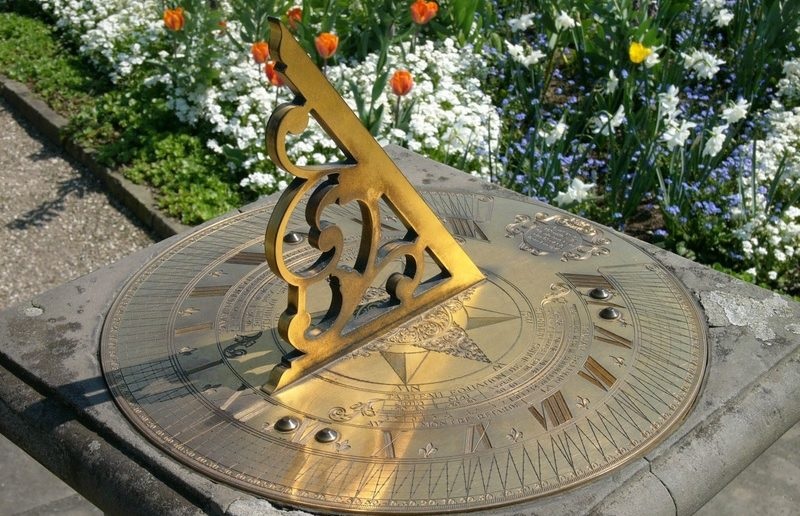
They appeared more than five thousand years ago. Despite the seeming simplicity, their device had its own characteristics. By design, they can be vertical, horizontal, equatorial, etc. The pillar, fixed in the center of the dial, was located at an angle equal to the latitude of the area. The dial was divided into 24 parts. Mark "12" corresponded to noon and was facing north. The exact time of the sundial was shown only between the days of the spring and autumn equinoxes and, of course, only in the light of the sun.
Clepsydra

Later in ancient Egypt, water chronometers appeared, representing a vessel from which water flowed in a small stream. The ancient Greeks improved their design and called them "clepsydra", from the ancient Greek "steal" and "water". The device now consisted of two vessels, one above the other. Water from the upper vessel flowed into the lower one, in which the float was placed, with a pointer sliding along the time scale.
Interesting! Clepsydra were especially popular in ancient Rome. They measured the time spent by lawyers in court. Apparently, this is where the well-known and widely used expression "Your time is up" came from.
Clepsydras developed continuously, became more precise and more complex, decorated with precious stones and metals, and counted the time right up to the 17th century. By the way, the first chronometers with an alarm function were the ancient Greek klepsydras. It happened somewhere in the year 250 BC. When the water in the lower vessel rose to a predetermined level, a mechanical bird whistled.
We also owe the appearance of the dial to the ancient Greeks. They calculated how many days it takes for the earth to go around the sun, and broke the circle into 360 parts (the Greek year was 360 days). Subsequently, such a breakdown was called grading, and its parts were called degrees. The division of the day into 24 hours was made in ancient Egypt. First, the day was divided into two halves, 12 hours each. From dawn to dusk - day, from dusk to dawn - night. During the year, the length of the day and night change, so that such a division was not very accurate. The situation was corrected with the advent of clepsydra. The number "12" appeared as a result of the definition of twelve lunar cycles.
Interesting! We owe the division of the hour into 60 minutes and minutes into 60 seconds to the ancient Sumerians. They used a 60-digit counting system. Progressive humanity, unlike the Sumerians, counts in hundreds, but time counts down, according to the Sumerian system.
Mechanical watches

In the late 16th and early 17th centuries, pendulum chronometers and a minute hand appeared. True, they were far from perfect, the amplitude of the pendulum was about 50 degrees and it had to be swung frequently. The first pendulum clock was created by Christian Huijens in 1656.

Since then, mechanical chronometers have undergone significant changes, have seriously decreased in size and began to show very accurate time. The pendulum gave way to a mainspring, and the instruments became more compact. However, chronometers with an alarm function appeared much later.
In the 17th - 19th centuries, during the period of rapid development of industry, the formation of factories and factories, specially appointed people were involved in the awakening of workers. In England this position was called knoker-up.

The first alarm clock can be called, at a stretch, a device assembled by American Levi Hutchins in 1787. Apparently he was used to waking up early in the morning, at 4:00. His apparatus worked only at this time. An alarm clock with a signal at a given time was created by Antoine Rodier, 60 years later, in 1847.
Quartz watch
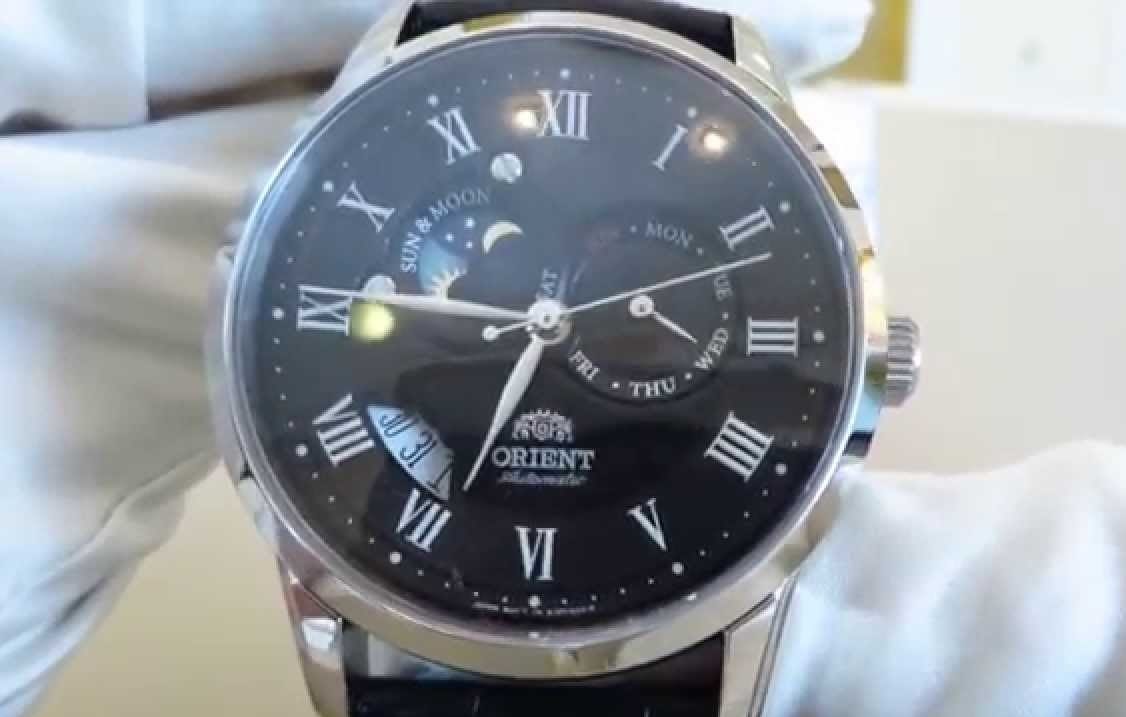
Quartz is a very widespread mineral on earth with interesting properties. Under the influence of an electric current, quartz crystals begin to vibrate at a constant frequency. This effect is used in quartz watches with high precision. Quartz crystals are used in superheterodyne radio receiver circuits to eliminate interference when receiving radio broadcasts. Thus, the product of interest to us is a combination of a radio receiver with high quality (no interference) receiving signals from high-precision chronometers with the function of giving a wake-up signal at a given time.
Types of modern alarm clocks
Devices that wake us up at a set time are one of the most essential devices in the life of every person, with the exception of retirees and freelancers. At the same time, there is hardly any other household appliance more hated by the ordinary worker than this one, which lifts us up at no light - at dawn, every day, excluding weekends, holidays and holidays.
 Manufacturers of such equipment indulge in all sorts of tricks, trying to make the process of waking up the user pleasant and charge him with vigor for the whole day ahead. Coffee lovers are invited to wake up in the morning to the smell of their freshly brewed favorite drink. Before the lift signal sounds, the machine brews coffee. This smell is the first thing that the owner of such a device begins to feel in the morning.The wake-up signal sounds a little later.
Manufacturers of such equipment indulge in all sorts of tricks, trying to make the process of waking up the user pleasant and charge him with vigor for the whole day ahead. Coffee lovers are invited to wake up in the morning to the smell of their freshly brewed favorite drink. Before the lift signal sounds, the machine brews coffee. This smell is the first thing that the owner of such a device begins to feel in the morning.The wake-up signal sounds a little later.
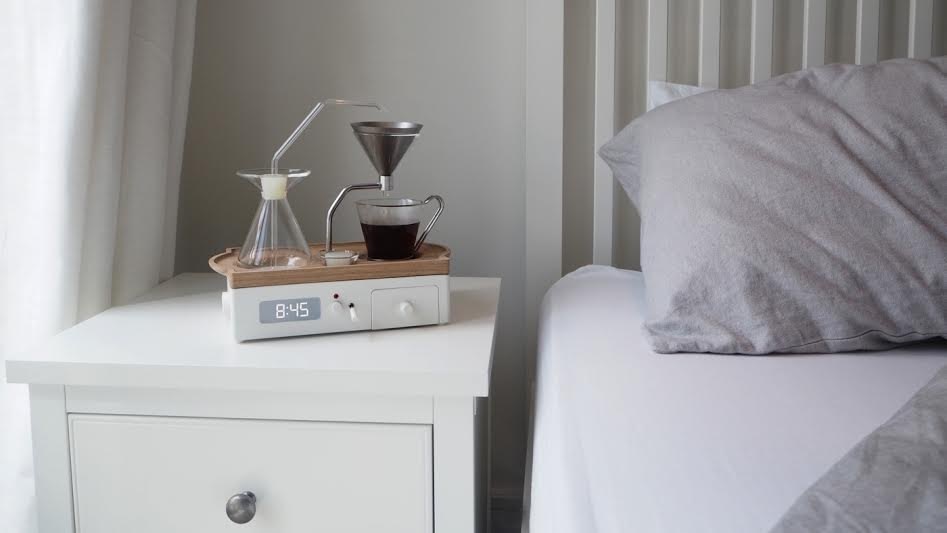
For those who cannot wake up immediately, flying alarm clocks have been developed. This is a propeller that starts from its base at the appointed time and flies around the room, emitting a lift signal. The trick is that you can't turn it off until you catch it and put it on the base.
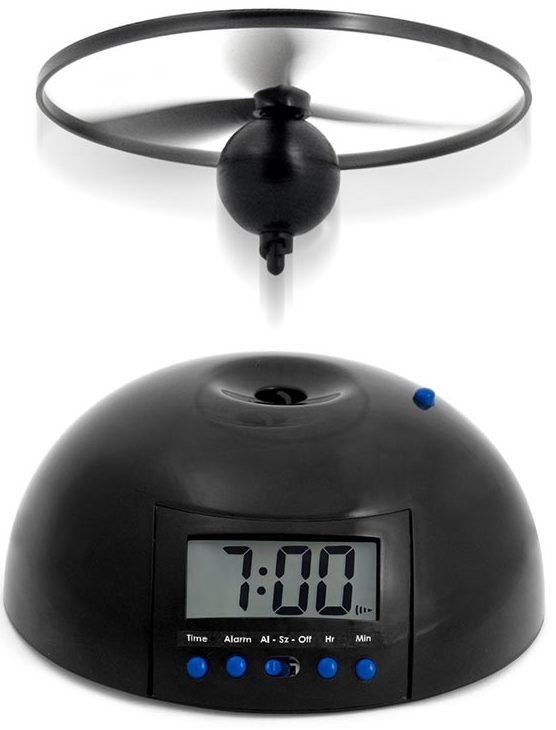
Another option for desperate sleepyheads is the vibrating ring. At the programmed time, the ring worn on the finger begins to vibrate. To turn it off, you need to shake your hand. However, vibration will turn on after some time, with a more sensitive amplitude, which will increase with each shutdown.

Recently, light alarm clocks are gaining popularity. Built-in mini lamp, at the set time, starts to glow with a gradual increase in brightness. The sound signal is triggered a little later. Many people like this.
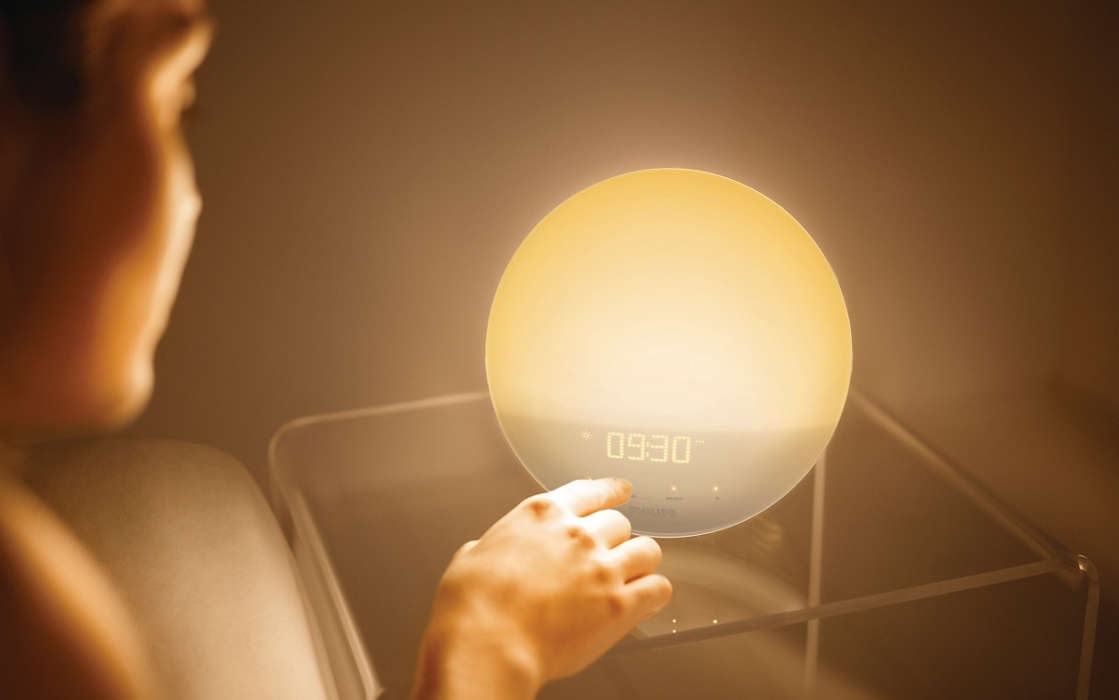
The most popular are radio alarm clocks. Instead of a sharp ringing tone, you can choose to wake up the sounds of your favorite radio station. Products of this type are capable of not only waking up, but also lulling the owner. By listening to pleasant melodies, you can quickly fall asleep. The sleep timer will automatically turn off the radio after a predetermined time.

A little about radios
Terrestrial radios

A radio receiver is called a device capable of finding radio waves in the air and converting their vibrations into sound signals carrying information. Terrestrial radio receivers differ from each other in the following characteristics:
- The range of received frequencies (or wavelength): LW - long waves, MW - medium waves MW, HF - short waves and VHF - ultrashort waves. In the VHF range, sub-bands are considered: domestic, with a frequency of 65.4 to 74 MHz and the western - FM range with frequencies from 87.5 to 108 MHz.
- Amplitude modulation (AM) and frequency modulation (FM). Simply put, AM and FM are two ways to clear the radio signal from interference. FM provides a very clean VHF signal.
- The tuner being used, digital or analog. Both options have advantages and disadvantages.
- In terms of dimensions, the receiver can be stationary and portable (portable or pocket).
- Receivers can be powered from mains, rechargeable batteries or batteries.
Internet Receivers

Internet receivers are considered the most advanced devices. These devices differ from terrestrial radio in the guaranteed excellent quality of received signals, regardless of the location of the receiver (there would be access to Wi - Fi), the ability to receive many thousands of Internet radio stations. The only but significant drawback of Internet receivers is the mandatory access to the Internet. Without it, the device is only an interior decoration. This disadvantage is leveled by some manufacturers, by embedding into the Internet device the ability to receive signals from the air.
Digital broadcasting
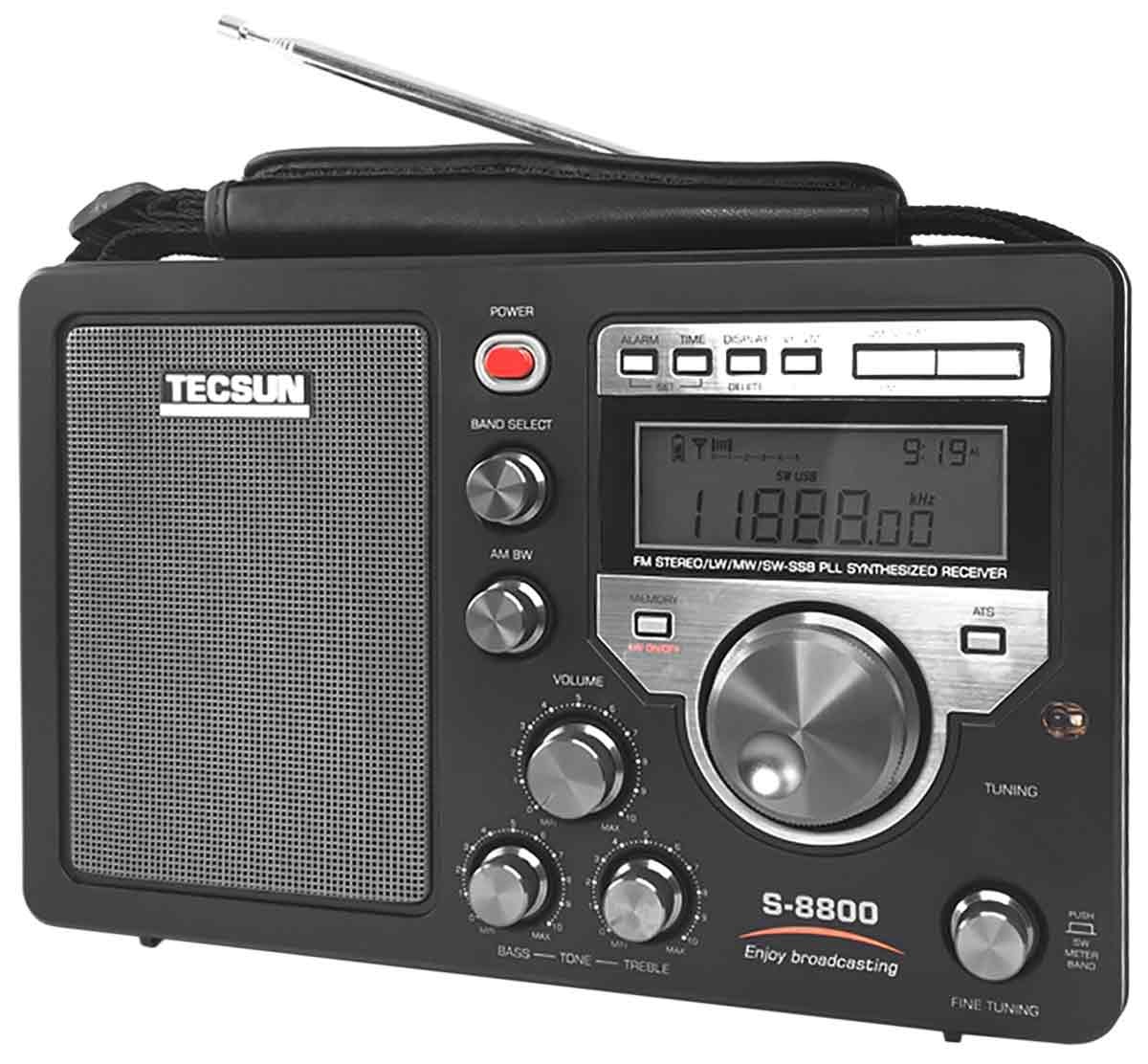
The use of digital technologies for processing radio signals during transmission and reception has a number of advantages over analog radio:
- In the LW, MW and HF bands, the quality of the received signal is significantly improved.
- More confident and high-quality reception of radio stations broadcasting in the VHF range for mobile and especially car receivers, where the reception quality is distorted as a result of multiple reflections of signals and vehicle speed.
- The number of terrestrial radio stations broadcasting in the FM range has almost reached its limit. Digital broadcasting combines them into multiplexes of 16 stations, and sends on the air packs of multiplexes, significantly expanding the "capacity" of the FM range.
- In addition to audio information, digital format makes it possible to transfer video, graphic and text content.
Digital broadcasting standards.
There are several of them, but we will focus on the most common ones. DAB (Digital Audio Broadcasting) and DAB + are widely used in Europe. In the USA - HD Radio. DMB (Digital Multimedia Broadcasting) was a technology that made it possible to listen to radio broadcasts on mobile phones, tablets and laptops.
Interesting! The term "Broadcasting" has been used in agriculture. Literally, spreading seeds. In the context of radio broadcasts, "broadcasting" means "widespread", i.e. radio broadcasts intended for a wide range of radio listeners.
This term got into the terminology of radio broadcasting thanks to the American inventor Charles Herrold, who built one of the first radio stations in San Jose in 1909. The use of agricultural terminology is due to Herrold's origins. His father was a farmer.
Criteria for choosing high-quality radio alarm clocks
To choose the right model, you need to familiarize yourself with the characteristics of all its components.
When evaluating the radio equipment of the device, the following parameters are taken into account:
- The quality of reception depends on the sensitivity of the receiver, and the higher it is, the more stations it will "catch". The parameter is measured in microvolts.
- The loudness of a speaker or speakers depends on its output power, measured in watts, and the higher it is, the louder the receiver is.
- According to the number of received bands, it is better to choose the one that is capable of receiving signals in the MW, DV, VHF / FM bands. Inexpensive models receive radio stations, as a rule, only in the FM range.
- Give preference to devices with digital frequency tuning and fixed tuner settings. And the more there are, the better. Having entered the found radio station into the memory of the device, the next time you can tune in to it by pressing one button. This is a very handy feature.
- It will be useful to have a headphone jack in the case to listen to the radio before bedtime, without disturbing the sleep of the household.
- It is highly desirable to have a USB connector for a flash drive.
- Pay attention to the sound quality of radio broadcasts. Mini audio systems have various advantages. Some of them reproduce speech information of high quality, but they do not cope well with broadcasting music programs. It also happens vice versa. Choose what is more important to you. The best choice would be a quality mini stereo system with two speakers.
Chronometer selection
When evaluating this piece of hardware, consider the following device features and capabilities:
- The height of the hour and minute digits should be large enough to be readily distinguishable at either end of the bedroom. Especially visually impaired people.
- It is better to choose the time format 24 - h, so as not to be confused with the designations AM and PM (before noon and after noon) in a twelve hour format.
- Choose a model with a display that is dimensioned (width and height) to distinguish the time from a distance. Some users, knowing the habit of turning off the call and “lying down a little more,” specifically set alarms away from the bed so as not to oversleep.
- The presence of a constant backlight is desirable if this function will not disturb at night.
- Quartz stabilization of the chronometer is required.
- Almost all models are powered from the mains. To maintain the settings in the event of a power outage, the model must be equipped with batteries. Please note that most devices are not designed to operate on batteries for extended periods. In the best case, in the event of a power outage, they will save the device's settings for three hours, no more. It is better if these are not batteries, but rechargeable batteries. It is even better if the rechargeable batteries or batteries are powerful enough to ensure the autonomous operation of the product.
- Pay attention to devices with a gradual increase in the wake-up signal. This will save your nerves from annoying sounds with an uncontrolled constant volume, which sometimes makes you want to bang the device against the wall.
- When choosing a device, be guided by its price.Cheap models have less functionality, but expensive ones do not mean better. Decide what you want from your product and analyze your financial capabilities.
What to look for
Take a closer look at the products with the projector. It is very convenient to wake up in the early morning, not to look for the display with your eyes, but to see the projection of the time digits directly on the ceiling or on the wall.
Some models are equipped with additional useful functions: the ability to work with USB disks and memory cards, MP3 support. The more such additions, the more expensive the device.
If you have no experience in operating such devices, collect as much information as possible about it: listen to the advice of experienced users, the recommendations of the seller in the store, read the description of the model, find out how much it costs.
Carefully read the operating instructions, especially the section explaining how to set up the device in order to wake up to the music of the radio station selected for this. This will make the awakening process more enjoyable.
Which company model is better to buy
When buying household electronic appliances, it is better to give preference to models from the best manufacturers, the popularity of models of which is based on the production of high quality products for many decades. To list all the world's brands, a separate article would be needed, so let's dwell on some of the most famous:
- Sangean. A Taiwanese company that produces popular radio models. Founded in 1974. The company's products are renowned for their high quality workmanship and retro design.
- Ritmix. Domestic manufacturer of consumer electronics. Differs in a wide range of good quality products at affordable prices.
- Harper. Another representative of Taiwan. Specializes in the design and manufacture of consumer electronics, audio systems, headphones, clock radio.
- Telefunken. The oldest brand from Germany, known since 1903. The main activity of the company is radio equipment and communication facilities.
- Sonu. Consumer electronics of the famous Japanese company are of high quality, constant innovation, and affordable prices.
- Buerer. Germano is a Hungarian company. He specializes in the creation of electronic devices in the field of healthcare. Innovative technologies are always at the heart of its developments. Models of her light radio alarm clocks are popular with buyers.
- Philips. A well-known company for the production of electronic household appliances from the Kingdom of the Netherlands. The popularity of its products is based on high quality, wide assortment and stylish design. Philips electronics have served users without breakdowns for many years. Its service centers are located in many countries around the world.
- Hyundai. A company from South Korea. Renowned passenger car manufacturer. Recently, the company has been developing and manufacturing high-quality consumer electronics.
- Oregon Scientific. A young, successfully developing company from the USA. Specializes in the development and production of systems “Smart House". Its goal is to continuously improve the quality of life of its customers. The company's motto is “Live wisely”.
Even such an incomplete list of manufacturers gives the buyer a wide choice of devices for every taste and wallet. Before buying, be sure to ask if there are service centers of the company - the manufacturer of your model in your region, so as not to repair the device yourself, especially during the warranty period.
Rating of high-quality radio alarm clocks
Max CR-2910
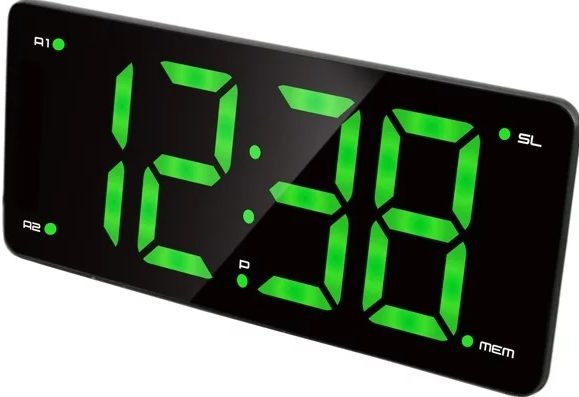
An overview of the budget segment of high-quality clock radio opens with a Chinese-made Max CR-2910. The model with an average cost of 1,488 rubles is appreciated by users for its good design, chronometer accuracy, and high-quality assembly. Confidently receives radio stations in the FM range. Up to 10 radio stations are recorded in the device's memory. The user has two alarms, a sleep timer, two batteries to save the settings after disconnecting from the mains. Tenth place in the ranking.
Advantages:
- a three-inch display and green backlighting of numbers are clearly visible for people with myopia;
- stylish design;
- high-quality assembly;
- affordable price.
Disadvantages:
- not the best speaker;
- not enough fixed settings.
Philips AJ 3116
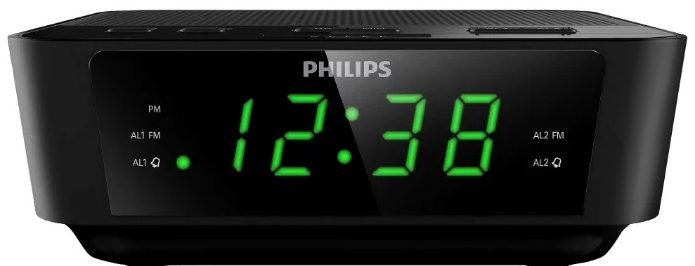
In ninth place is the Philips AJ 3116, representing the world famous brand from Holland. The unit receives FM radio stations. The frequency setting is digital. Those who do not wake up immediately are first woken up by a regular signal. After a certain time, the "sleeping" user will be woken up by the sounds of music from one of ten favorite radio stations recorded in the device's memory. The owner can use the sleep timer function to fall asleep to their favorite tunes. After the set time (15 to 120 minutes), the radio will be silenced. The product is powered by a network. In the event of a power outage, the device automatically switches to battery power (2 x AAA), keeping all settings. The average price of Philips AJ 3116 is 1190 rubles.
Advantages:
- stylish design;
- excellent reception of radio stations;
- power supply from mains and batteries;
- sleep timer.
Disadvantages:
- tight movement of the buttons;
- rigid fixation of radio stations in memory, requiring you to turn over the entire list to access the desired station;
- according to buyers, the memory capacity for 10 stations is insufficient.
Ritmix RRC-606
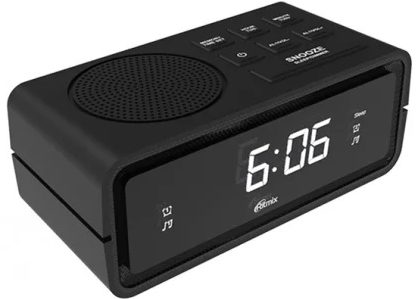
The eighth line of the rating is occupied by the domestic apparatus Ritmix RRC-606. It is appreciated by users for a very affordable cost and decent functionality. The unit receives radio stations in the FM band. The memory stores up to 20 stations. Mains power is backed up by two AAA batteries, which retain the settings in case of a power outage. To wake up the owner, two alarms are provided. In addition, there are sleep timer and display backlight adjustment functions. Average price of the model: 690 rubles.
Advantages:
- stylish design;
- user-friendly interface, location of buttons on top;
- up to 20 fixed settings;
- the ability to adjust the brightness of the backlight.
Disadvantages:
- loud "clicking" of buttons;
- at maximum volume, “wheezing” appears in the dynamics;
- the minimum volume could be lower.
Hyundai H-RCL220
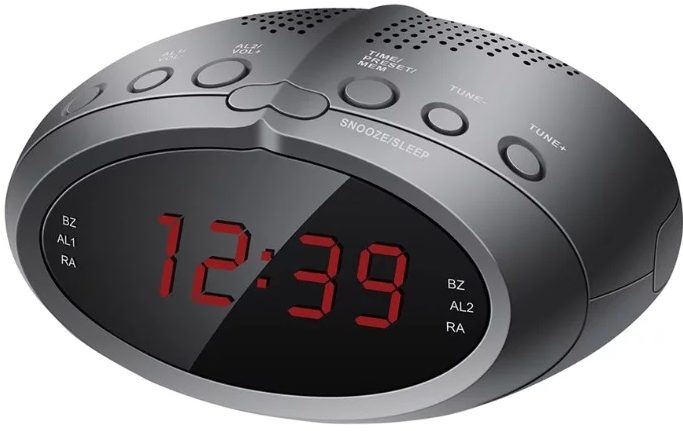
The seventh in our ranking is the South Korean model Hyundai H-RCL220. The products of this company are famous for their design and quality. The H-RCL220 is no exception. Very stylish body, convenient location of the buttons (top). The display is elliptical. Glare-free screen. FM radio reception is excellent with no sound distortion. Includes two alarm clocks. One works in a snooze mode. The second one includes music from one of 20 radio stations recorded in the device's memory. There is a sleep timer. And this pleasure costs only 705 rubles. This is its average price.
Advantages:
- excellent sound, no "wheezing" and distortion at any volume;
- cool design;
- excellent build quality;
- 20 fixed stations;
- Excellent value for money and quality.
Disadvantages:
- not found.
HARPER HCLK-2042
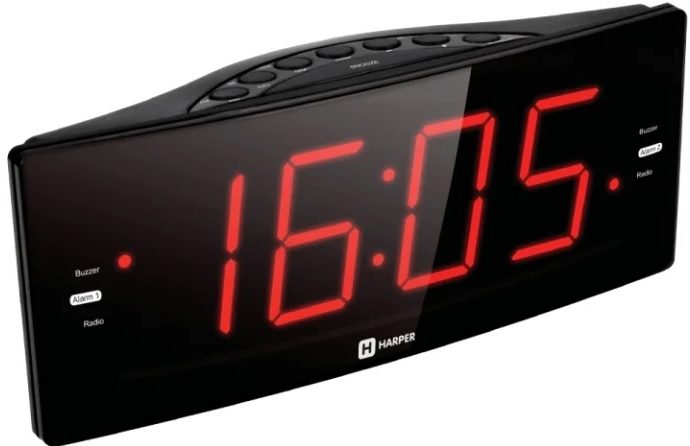
In sixth place is the model from Taiwan HARPER HCLK-2042. Quite a budget product with an average price of 1,083 rubles. For little money, the buyer gets a device with good functionality. Nice design. The display with large, slightly less than 50 mm, numbers is very popular with all users, especially the elderly and people with low vision. The color of the numbers is red-orange, does not irritate the eyes. The information is clearly visible at night. The device has two degrees of brightness. Confidently receives signals from radio stations in FM, VHF and MW bands. The memory is preset to 20 stations. The presence of two alarms and snooze signals ensure that the owner is awakened on time.
Advantages:
- stylish design;
- large size of numbers on the display screen;
- reception of radio stations in three different ranges;
- affordable price.
Disadvantages:
- batteries are not designed for stand-alone operation;
- only to save settings during periods of power outages;
- the desired station is found only by scrolling the entire list forward.
Sony ICF-C1T
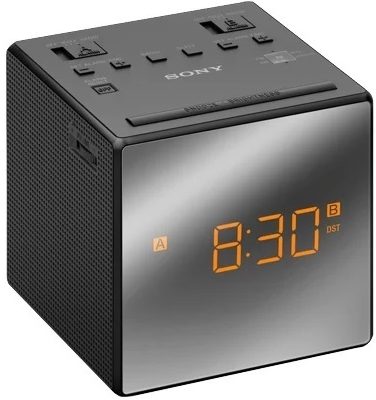
The fifth number in the ranking is a model from the Japanese brand Sony ICF-C1T, famous for its high-quality electronics. The design and electronics of the model are at their best, as befits products from the land of the rising sun. The body of the model can be painted in black and red. The unit receives stations in FM and MW (AM) bands, with analogue frequency tuning. Users like it for the unobtrusive signal that sounds with increasing volume. The yellow color of the numbers on the display does not irritate the eyes. For those who like to lie down "just a little more", there is a button for delayed sleep, which allows you to extend your stay in the "embrace of morphea" by 10 minutes with one click. And if you press it three times, then for thirty minutes. The price is affordable, on average - 1926 rubles.
Advantages:
- stylish design;
- high-quality assembly;
- rising signal;
- sleep timer;
- after a power outage, the settings do not go astray;
- affordable price.
Disadvantages:
- analog frequency setting does not allow fixing "caught" stations in the device memory.
Telefunken TF-1582UB
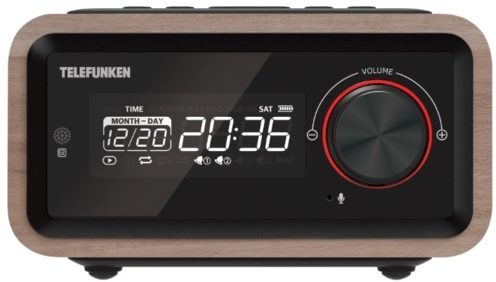
The fourth number in the rating is the product of the famous German company Telefunken TF-1582UB. A radio with a sound power of 6 W, confidently receives radio stations in FM and VHF bands, with fixing up to 50 settings. The device can work with USB and CD media. There is Bluetooth and a remote control. Two speakers transform the product into a mini stereo system. The device allows you to remember the place where a piece of music was stopped. Recording is rewound from the remote control, any track is selected by pressing the corresponding button. Two alarms and snooze remind the user of the main function of the device.
Advantages:
- confident reception of radio stations in the FM and VHF bands;
- excellent stereo sound;
- fixing 50 settings;
- cool design;
- excellent build quality.
Disadvantages:
- no built-in battery (purchased separately);
- the radio does not turn on as a wake-up signal (not provided);
- remote buttons are inconvenient;
With all its advantages, the alarm clock in this device is much inferior to the radio receiver. The average cost of the device is 2,400 rubles.
Beurer WL30
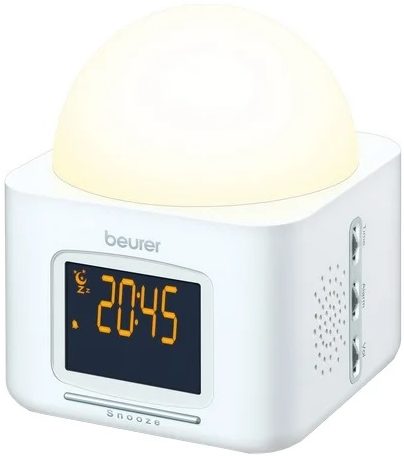
In third place in the ranking is the product of the German-Hungarian company Beurer WL30. The developers have equipped their device with a lamp. Before the signal sounds, the luminaire starts to "flare up" gradually. In addition to the light, there is a traditional alarm clock, with the choice of a telephone buzzer, the voices of birds, frogs, or turning on a radio station, which you can tune in to in the FM band. The device may wish the user good night. He does this by gradually reducing the brightness of the glow to zero. The color of the numbers on the display can be switched from blue to orange. The purchase of such a product will cost 4200 rubles.
Advantages:
- light signal with a gradual increase in brightness;
- convenient push-button control;
- build quality.
Disadvantages:
- bird and frog voices do not sound natural;
- tight movement of the buttons, "jamming" is possible.
Oregon Scientific RRM222PN

The second place is occupied by an interesting model by the American company Oregon Scientific. In our review, this is the only clock radio with a projector. In order to find out how much time is left before the ascent, you do not need to look for the display screen with your eyes, turn on your side and generally perform any actions. It is enough to open your eyes. The projection of information from the display is located on the ceiling, right in front of the user's eyes. If you wish, you can deploy the projection onto the wall, at any convenient place. The device receives radio stations in the FM range, is equipped with a wireless external thermometer. In fact, this is a hybrid of an alarm clock, a radio receiver and a weather station, with the ability to connect five external weather sensors with a range of no more than 50 meters. The display provides information on the current time, date and outdoor temperature, has a backlight and an indicator of the battery charge of the temperature sensor. There is a calendar. This hybrid will have to pay about 4690 rubles. This is the average price.
Advantages:
- the presence of an information projector on the wall or ceiling;
- accurate readings of the outside air temperature;
- the ability to bind 5 external weather sensors to the device;
- confident reception of radio stations in the FM range.
Disadvantages:
- not found.
Sangean WR-2

The first place and the best customer reviews goes to a product from Taiwan, from the Sangean company, model WR-2. Users love the retro design of the phone. On the front panel there is a knob for tuning the receiver to radio frequencies in the FM and CD ranges, sound volume control, a sufficiently large speaker and an informative display. The device can record up to 10 radio stations. On the front of the case there are buttons for selecting radio stations, a headphone jack, and an alarm clock setting button. The body material (wood) and its volume contribute to the reproduction of high quality stereo sound, as evidenced by numerous rave reviews from users. The kit includes a remote control.
Advantages:
- stylish design;
- excellent sound of radio broadcasts;
- memory for 10 radio stations;
- control from the remote control.
Disadvantages:
- insufficient memory to fix more settings;
- high price.
| Model name | Specifications | Average price |
|---|---|---|
| Sangean WR-2 | Type - radio alarm clock. The frequency setting is digital. Reception - FM, CB. The number of speakers is 1. Headphone jack - yes. Information display - display. Functions - hours. Mains powered - yes. Additional Information: base made of wood, detachable wire, alarm clock, remote control. | 10999 rubles |
| Oregon Scientific RRM222PN | Type - radio alarm clock. Frequency setting - digital; reception - FM. The number of speakers is 1. Information display - display, projector. Functions: clock, thermometer. Batteries - 2xAAA; there is power from the network. Dimensions (WxHxD) - 200x80x22 mm; weight - 0.22 kg. Additional Information: the calendar. | 4690 rubles |
| Beurer WL30 | Type - radio alarm clock. The frequency setting is digital. Reception - FM. Information display - display. Functions - clock; mains supply - yes. Additional Information: night light, awakening due to gradually increasing light brightness, signal selection: radio, birds chirping, frogs croaking, rainstorm, wind, standard buzzer; good night function (gradually decreasing light brightness), three levels of display brightness, blue / orange display color switching. | 4200 rubles |
| TELEFUNKEN TF-1582UB | Type - radio alarm clock. The frequency setting is digital. Reception - FM, VHF. The number of tuner presets is 50. The number of speakers is 2. Sound power - 6 W. MP3 playback - yes. Media support - SD, USB. Information display - display. Functions - hours. Mains powered - yes. Additional Information: 2 alarms, snooze, calendar, line-in, bluetooth, remote control. | 2400 rubles |
| Sony ICF-C1T | Type - radio alarm clock Frequency setting - analog; FM reception, CB. The number of speakers is 1. Information display - display. Functions - hours. Batteries - 1xCR2032. Mains powered - yes. Dimensions (WxHxD) - 101x102x101 mm; weight 0.49 kg. Additional Information: two alarms, snooze alarm, sleep timer. | 1926 rubles |
| HARPER HCLK-2042 | Type - radio alarm clock Frequency setting - digital; reception: FM, HF, SW. The number of tuner presets is 20. Number of speakers - 1; sound power - 0.5 W. Information display - display. Functions - clock; there is power from the network. Dimensions (WxHxD) - 200x70x82 mm; weight - 0.44 kg. Additional Information: 2 alarms, snooze alarm. | 1083 rubles. |
| Hyundai H-RCL220 | Type - radio alarm clock. Frequency setting - digital; reception - FM. Information display - display. Functions - clock; mains supply - yes. Additional Information: 2 alarms, snooze alarm, sleep timer. | 705 rubles |
| Ritmix RRC-606 | Type - radio alarm clock. The frequency setting is digital. Reception - FM. The number of speakers is 1. Information display - display. Functions - hours. Batteries - 2xAAA; mains supply - yes. Additional Information: 2 alarms, snooze alarm, off timer, dimmable. | 690 rubles |
| Philips AJ 3116 | Type - radio alarm clock. The frequency setting is digital. Reception - FM. The number of speakers is 1. Information display - display. Functions - hours. Batteries - 2xAAA. Mains powered - yes. Dimensions (WxHxD) - 130x46x130 mm; Weight - 0.26 kg. Additional Information: two alarms, snooze the alarm after 9 minutes, sleep timer (15/30/60/90/120 minutes). | 1190 rubles. |
| Max CR-2910 | Type - radio alarm clock. The frequency setting is digital. FM reception. The number of speakers is 1. Information display - display. Functions - hours. Batteries - 1xCR2032. Mains powered - yes. Dimensions (WxHxD) - 102x39x22 mm. Additional Information: 2 alarms, sleep timer, battery only for saving settings | 1488 rubles. |
The radio alarm clock will not only wake you up, but will make waking up pleasant, giving you a charge of a positive attitude from the very morning and all day long. In addition, such devices will not only wake up, but also lull the owner with the sounds of music from one of the radio stations, and then turn off at a specified time. During the day, they show the time like a chronometer, broadcast news and music programs like a radio receiver.

In short, a potential user has many reasons to buy this multifunctional device and take another step towards improving the quality of life. Our site will help you not to make mistakes when choosing a decent model.












